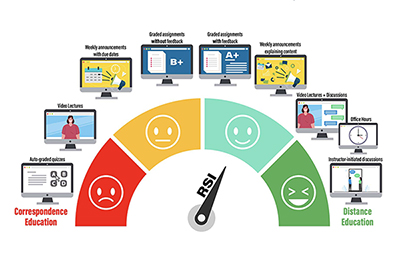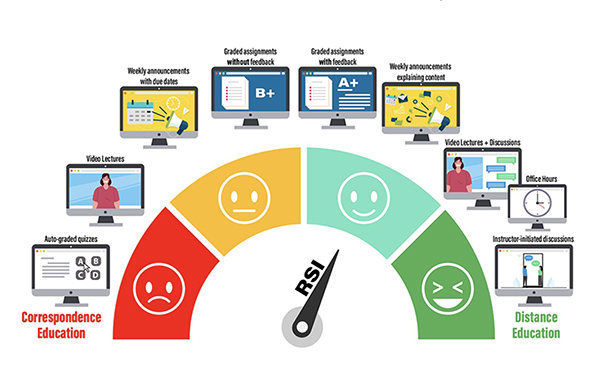| |
 |
| |
SUNY Online offers this graphic that shows a range of activities to help distinguish high quality DE courses from mere correspondence courses. The FA is working to keep our members apprised of what regular, substantive interaction looks like in a variety of disciplines and courses. |
| |
|
When teaching a distance education (DE) course, it's long been considered a best practice to engage in regular and substantive interaction with our students, but did you know it's now a federal law to do so?
Effective July 1, 2021, the U.S. Department of Education enacted new regulations for DE courses designed to distinguish quality online college courses from mere correspondence courses, which is critical for institutions that receive federal financial aid.
The most significant part of this update is how the federal government defines distance education, academic engagement and regular and substantive interaction.
I share the federal language below, followed by some discussion, information and advice on each aspect of these new regulations. (Also, I hope you've also been following Murph Kinney's "Teaching online: Getting better gradually" columns in each issue of The WORD. She shares smart suggestions every time, and there's always room for improvement.)
New Definitions Effective July 1, 2021
[sources: Federal Register, vol 85, no 171, 9/2/20 (or Federal Register and scroll down to Part 600—Institutional Eligibility Under the Higher Education Act of 1965 As Amended) and/or visit Cornell University Legal Information Institute]
Distance education:
(1) Education that uses one or more of the technologies listed in paragraphs (2) (i) through (iv) of this definition to deliver instruction to students who are separated from the instructor or instructors and to support regular and substantive interaction between the students and the instructor or instructors, either synchronously or asynchronously
(2) The technologies that may be used to offer distance education include: (i) The internet; (ii) One-way and two-way transmissions through open broadcast, closed circuit, cable, microwave, broadband lines, fiber optics, satellite, or wireless communications devices; (iii) Audio conference; or (iv) Other media used in a course in conjunction with any of the technologies listed in paragraphs (2) (i) through (iii) of this definition
(3) For purposes of this definition, an instructor is an individual responsible for delivering course content and who meets the qualifications for instruction established by an institution’s accrediting agency.
(4) For purposes of this definition, substantive interaction is engaging students in teaching, learning, and assessment, consistent with the content under discussion, and also includes at least two of the following —
(i) Providing direct instruction;
(ii) Assessing or providing feedback on a student’s coursework;
(iii) Providing information or responding to questions about the content of a course or competency;
(iv) Facilitating a group discussion regarding the content of a course or competency; or
(v) Other instructional activities approved by the institution’s or program’s accrediting agency
(5) An institution ensures regular interaction between a student and an instructor or instructors by, prior to the student’s completion of a course or competency:
(i) Providing the opportunity for substantive interactions with the student on a predictable and scheduled basis commensurate with the length of time and the amount of content in the course or competency; an
(ii) Monitoring the student’s academic engagement and success and ensuring that an instructor is responsible for promptly and proactively engaging in substantive interaction with the student when needed on the basis of such monitoring, or upon request by the student.
* * *
Active participation by a student in an instructional activity related to the student's course of study that
(1) Is defined by the institution in accordance with any applicable requirements of its State or accrediting agency;
(2) Includes, but is not limited to:
(i) Attending a synchronous class, lecture, recitation, or field or laboratory activity, physically or online, where there is an opportunity for interaction between the instructor and students;
(ii) Submitting an academic assignment;
(iii) Taking an assessment or an exam
(iv) Participating in an interactive tutorial, webinar, or other interactive computer-assisted instruction;
(v) Participating in a study group, group project, or an online discussion that is assigned by the institution; or
(vi) Interacting with an instructor about academic matters; and
(3) Does not include, for example (i) Living in institutional housing; (ii) Participating in the institution's meal plan; (iii) Logging into an online class or tutorial without any further participation; or (iv) Participating in academic counseling or advisement.
Discussion of RSI
RSI refers to regular, substantive interaction, which is the core of the new federal regulations. As noted above, these have long been considered good practice in DE but are now required for institutions to be eligible for federal financial assistance. Thus, I offer some further discussion of several aspects of the July 2021 updated guidelines below.
Substantive interaction
Substantive means referring to the substance, or subject matter, of the course being taught. Therefore, as noted in the new federal regulations, the active engagement of students through teaching, learning, or assessment must be characterized by at least two of the following activities:
- Providing direct instruction
- Assessing or providing feedback on a student’s coursework
- Providing information or responding to questions about the content of a course or competency
- Facilitating a group discussion regarding the content of a course or competency
- Other instructional activities approved by the institution’s or program’s accrediting agency.
Instructor-student interaction being explicitly connected to the course content means that merely posting an announcement reminding students of an assignment deadline or reminding students about your participation policy do not qualify. Those deal with course policies, not course content. Substantive interaction explicitly aims to help students achieve the learning outcomes of the course.
This might include providing feedback on individual student assignments, actively facilitating online discussions, posting announcements or emailing the class about academic aspects of the course, or creating and posting an interactive tutorial or video about the week’s content (a video may not qualify if students aren’t required to interact with the video content and instructor after viewing).
Regular interaction
As noted in the federal regulations, to ensure regular instructor-student interaction, the college needs to be able to document that faculty are engaging in frequent, consistent, scheduled, and predictable interactions with students, such as.
- Providing the opportunity for substantive interactions with students on a predictable and scheduled basis appropriate for the duration, content, and level of the course
- Monitoring students’ academic engagement and success
- Promptly and proactively engaging in substantive interaction with students as needed or as requested by students.
This might include actively facilitating group discussions, providing individualized feedback on student work, and emailing students regarding their academic progress in your course.
Instructor-initiated interaction
It should be clear here too that faculty need to be initiating these substantive and regular—frequent, consistent, predictable—interactions with students. SUNY Online best practices indicate that in a typical 15-week semester, instructor-student interaction needs to happen weekly.
This might include posting weekly announcements regarding the substance of assignments to be completed that week, assessing student work (automatically graded materials, quizzes and exams do not count, unless you’re also responding individually to short answer/essay portions of those), actively facilitating a conversation in the discussion board or holding a weekly online review session.
Merely notifying students of how to contact you if they have questions does not qualify.
SUNY Online offers this useful graphic on regular and substantive interaction to illustrate how the 2021 federal guidelines make a distinction between correspondence courses and effective distance education courses. As always, contact me if you have any questions about the new RSI regulations.

|

